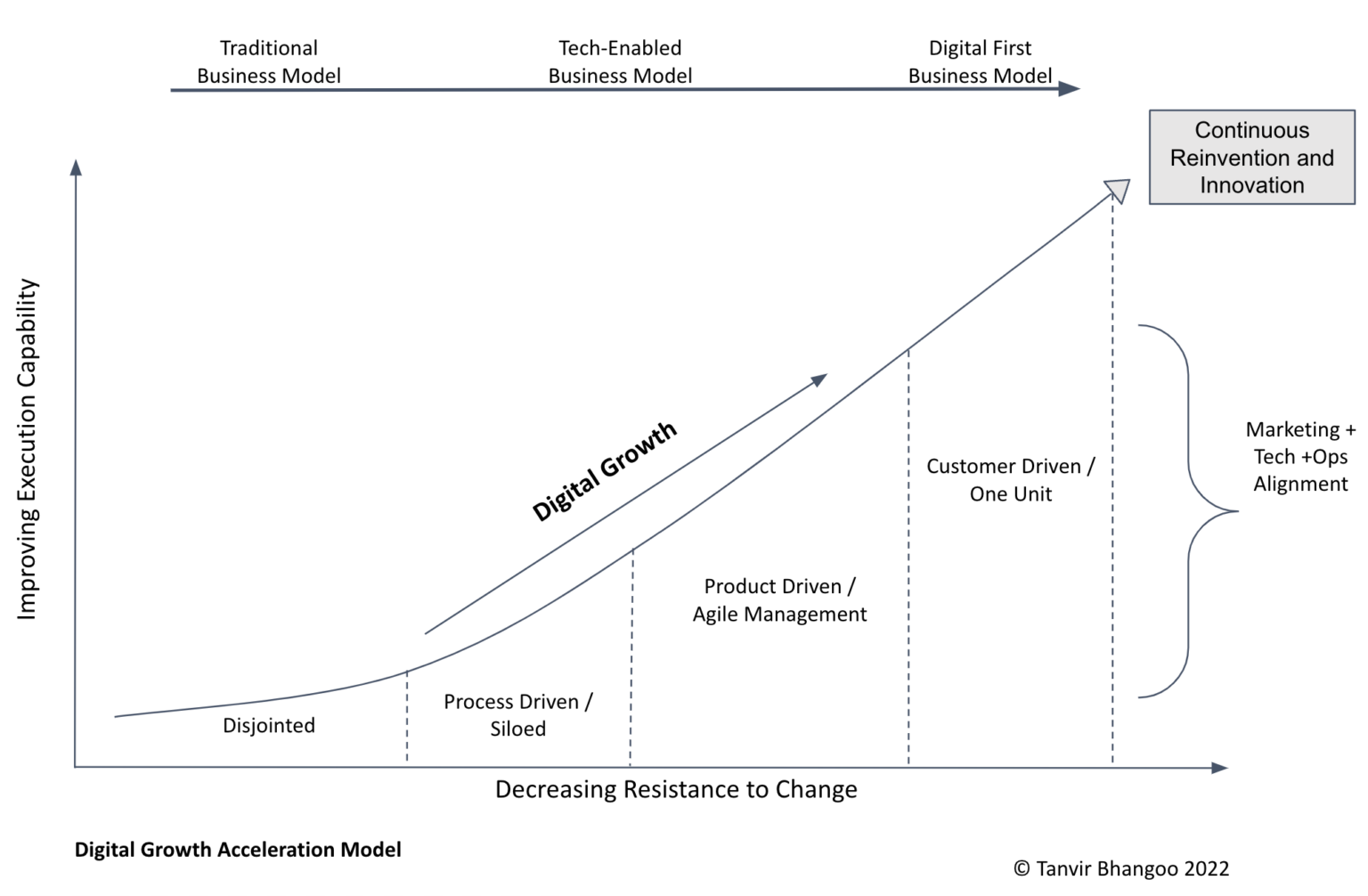What is Digital Growth Acceleration?
Digital growth acceleration is the rate of growth of your business’ revenues through digital channels. This has become a core component of business strategies for all CEOs across organizations as part of their transformational journey, especially post pandemic. Before we dive into the key components of digital growth, and various strategies available to executives to accelerate growth, let’s first look at a widely used, poorly misunderstood term – digital transformation.
What is a digital transformation?
During my career as a corporate executive and now advising C-suite clients, I’ve asked many leaders how they would define a ‘digital transformation.’
Usually, the responses are without any pattern or similarity. Answers include wide variety of areas such as modernizing technology, launching an app, finding new customer channels, better workplace collaboration, moving to the cloud, finding efficiencies, integrating standalone technologies, innovation roadmap, etc. etc. etc.. While all these are components of a digital transformation, they do not holistically define a digital transformation.
Here is my attempt at summarizing what a digital transformation really is:
A journey where a business attempts to shift revenues from traditional channels to digital channels by investing in technology while transforming and re-aligning its business-model, people, and processes.
You may agree with this definition, or believe that it should include other key components. But for the purposes of this blog, I’ll be using this definition to define ‘digital growth’.
Digital Transformation vs. Digital Growth Acceleration:
If digital transformation is a means, then digital growth is an end. It’s one of the key outcomes that businesses define (or quite frankly, should define) as part of their transformational efforts. The other outcome is operational efficiencies (the cost savings and productivity side of the equation).
Now, digital growth can be defined as revenue, which is a product of ‘price’ x ‘volume.’ But, revenue acceleration requires a combination of 4 key components that influence a business’ ability to drive volume at an increasing pace, as illustrated below.
Digital Growth Acceleration Model:
Digital growth acceleration model is illustrated in figure 1 below. It defines the key components that influence the level of digital growth for a business. Controlling and improving on each component allows a business to accelerate the rate of its growth. I.e. the rate at which your business and digital revenues are growing.

Let’s dive into these one by one.
-
Digital Strategy (business-model): Top of the chart (left to right)
This is a company’s business strategy aligned to a reimagined business model. As you go from left to right, you move from a traditional business model (ex. brick and mortar / manual), to a tech enabled business model (ex. omni-channel), to a digital-first business model (ex. customer driven cross channel).
Business model, in simplistic terms is defined as how a company makes money. To shift from the left to right in the chart requires a company to invest in the right technologies, realign the organization and roles to new customer channels, streamline processes, and re-define its operations (office, in-store, warehouse, off-premise, etc.).
-
Execution ability: Represented on Y Axis.
Most transformations, projects, and initiatives don’t fail due to strategy, but due to poor execution. As you go up, the Y axis represents an improving execution capability to deliver key strategic outcomes.
This includes leadership’s ability to simplify and communicate the digital strategy, clarify who does what and how success is measured (performance management), model the right behaviors and gain commitment, make quick decisions, and hold each other accountable, amongst other implementation items.
-
Decreasing resistance to change: Represented on X Axis
A big impediment to digital success is employee resistance, as per recent research and data. Going from left to right represents a decrease in change resistance as a result of transformational efforts.
Companies that drive digital growth are able to address internal conflict and minimize politics, eliminate any turf wars, strengthen relationships both internally and externally, and open lines of communication (and listening) at the employee level, top down, and bottom up.
-
Marketing – Tech – Ops Alignment: Bottom of the graph (left to right)
I believe true digital growth requires marketing, tech, and ops working together seamlessly as one team to
(1) launch profitable products and services (marketing / tech),
(2) maximize speed to market (tech / ops), and
(3) consistently react to consumer demands (ops / marketing)As you go from left to right, marketing, tech, and ops shift from being disjointed, to siloed, to product driven, and then to ultimately bring customer driven. These changes require building the right capability (technical and soft skills), realigning these three functions and processes between these functions, and redefining success metrics that encourage the right behaviours. As this team becomes one unit, engagement rises, it becomes a self managing function, and turnover also decreases.
-
Digital growth acceleration rate and continuous reinvention (End point)
This is the rate of growth, represented by the upward slanting line on the graph. A company that is operating on the far top-right will be able to constantly reinvent itself in the face of disruption.
Don’t mistake a burst of digital growth for sustainable growth acceleration (as many did during 2020/2021. Oftentimes we see companies enter new markets and find new market share, acquire new customers via company acquisition, or meet rising demands brought on by COVID, only to realize that growth cannot be sustained. This results in layoffs, lowering projections, and a whole other array of issues at the strategic level. The key is to be disciplined and focus on all four components above, even though not all may seem like a screaming priority.
Implementation:
Most companies today, despite the pandemic boost, are somewhere in the middle of this graph. There are some companies on the far left who have declared bankruptcy over the past few years, or are on a downward spiral. Then there are some who are leading the pack on the far right, and constantly reimagining themselves.
First, assess where your company stands on this model across all four components. This will give you a good idea of where you are, what direction you need to go in, and what to prioritize. For example, perhaps you have a strong strategy, but all of your projects seem to underdeliver and cause a lot of noise within your teams. Which means execution may be the underlying issue and focus.
Then, identify the steps you need to take today as an executive for your business to move in the right direction.
Here are a few areas you can dive into as part of your assessment:
1- Digital strategy and business model alignment:
- Do you have a good sense of your new business model? Where are your customers going and what digital revenue channels to invest in?
- Do you have the right technology roadmap in place, to make the most of what you have today, while you invest and build for the future?
- Does your strategy take into account how your organization needs to change from a people and process standpoint?
2- Analyze your execution capability:
- How would you rank your leadership team’s capability on decision making, pivoting, and gaining commitment to execute on a digital-first business model?
- Is your strategy communicated in simple terms, and do you have a clear sense of your goals, objectives, metrics, and key accountability of results across your executive team and below?
3- Uncover change resistance
- Do you see resistance to new programs at the employee level? I.e. is there constant pushback?
- Do you have commitment on your strategic roadmap and vision? Or are teams or individuals just going through the motions?
- Are teams open to implementing what’s best for the company, or are decisions ego driven and turn into turf wars?
4- Marketing – tech – ops stance:
- When you ask for data on your customer purchases across various traditional and digital channels, is it readily available, or do different teams have to pull this together?
- How long does it take for your business to launch a new product, let’s say an LTO, a new campaign, a new service, an app update, etc.? Identify how marketing, tech, and ops can move things faster (hint: sit under the same roof)
Tanvir Bhangoo is a consultant and advisor who works with C-level executives, helping them accelerate their digital growth and boost operational efficiencies. He’s also a bestselling author and a former tech executive. He’s a graduate from DeGroote School of Business MBA program, and also a collegiate football national champion.
Contact: you can reach him directly at tanvir@tbxdigital.com
” In what I now know is Tanvir’s signature style, Tanvir was able to rally the right people, align, focus and drive the project to completion without using fear or ego.” – Jeff Adamson, Cofounder, SkipTheDishes and Neo Financial
“In a world of digital disruption and where our minds never stop to rest, his stories and insights remind us of the basics (and not so basics) necessary to making big plays in business and in life.” – Kelly MacPherson, CTO, Union Square Hospitality Group

 Digital Growth Acceleration Model: 4 Components to Accelerating Digital Growth
Digital Growth Acceleration Model: 4 Components to Accelerating Digital Growth